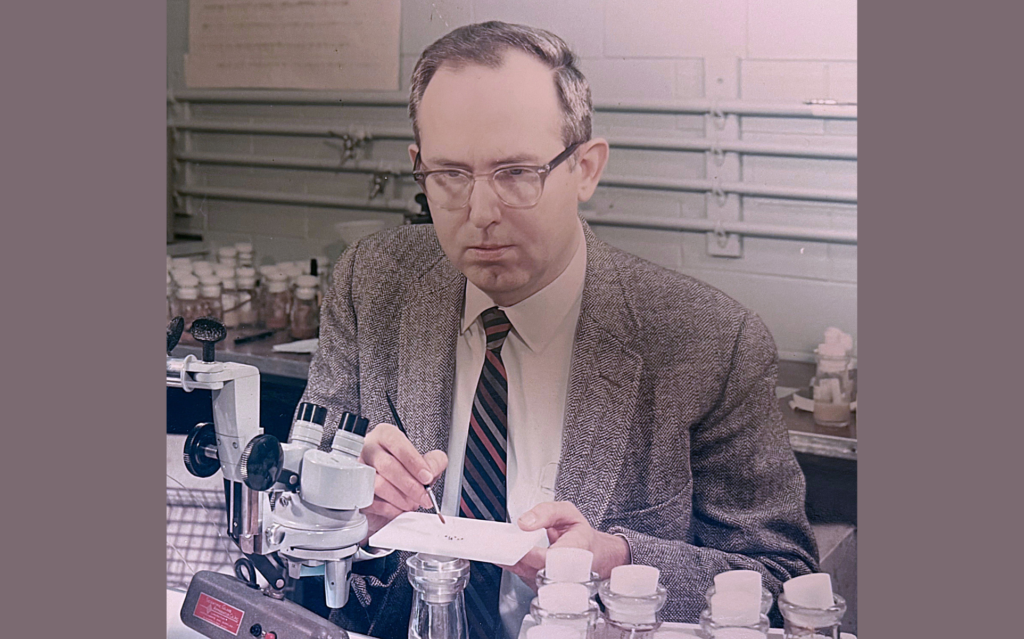Ellsworth (Ed) Grell blessed the Drosophila community through three enduring legacies: as a pioneer of chromosome mechanics, as a primary organizer and synthesizer of genetic knowledge in Drosophila, and as a graceful mentor to those fortunate to have known him personally.
Ed grew up in rural Nebraska, completed his undergraduate studies at Iowa State, and trained with E.B. Lewis as a graduate student at Caltech, insightfully analyzing the role of two interacting genes involved in the degradation of the amino acid lysine in his doctoral thesis.1 It was also in the Lewis lab that Ed met and then married his lifetime genetics colleague and soulmate Rhoda Frank Grell. They moved to Oak Ridge, Tennessee, where Ed remained until 1985.
Throughout his career, Ed contributed to developing precisely engineered chromosomes central to creating chromosome balancers, targeted translocations, or chromosome fusions.2-6 He used these sophisticated genomic tools to follow complex genetic traits in insightful and imaginative ways. For example, Ed was a leader in the arena of linking molecular phenotypes to genetic polymorphisms and enzyme dosage effects, using what were then cutting-edge gel electrophoresis techniques.7,8 Ed also collaborated with Dan Lindsley at the Oak Ridge National Labs to investigate the genetic basis of spermatogenesis, finding that the haploid post-meiotic phase to generate functional spermatids could proceed in the absence of chromosomes.9
Ed is perhaps most appreciated by the Drosophila community for his collaborative work with Dan Lindsley in assembling the “Genetic Variations of Drosophila melanogaster,” commonly referred to affectionately as the Red Book (because of its cover’s color). This wonderful reference book by Lindsley and Grell, published in 1968, distilled all phenotypic and genetic information regarding known Drosophila mutants at the time and provided helpful hints such as ranking mutant alleles on an RK scale based on scoring difficulty. Theodosius Dobzhansky succinctly summarized the achievement of this opus in his Science book review:10
“Here, at last, is the long-awaited compendium and a guide to the study of the genic and chromosomal variations in Drosophila melanogaster described in world literature. The book modestly calls itself a revision of the C.B. Bridges and K.S. Brehme’s The Mutants of Drosophila melanogaster, published almost a quarter of a century ago. In fact, it is a new and monumental work, embodying what must have been a prodigious amount of meticulous and conscientious work on the part of the authors.”
When Oak Ridge closed down its Genetics Section in 1985, Ed relocated to the Bay Area where he became a central member of the research group led by Lily and Yuh Nung Jan at UC San Francisco until his retirement. Ed helped design both small- and large-scale genetic efforts in the Jan lab and patiently mentored those of us new to the field, sharing his many clever tricks of the trade and his deep historical knowledge of the field. He was a gentle and humble gem of a human being and I feel fortunate to have known him as both a close colleague and friend.
Acknowledgements: Thank you to Lily and Yuh Nung Jan, Susan Younger, Kimberly McCall, and other members of the Jan lab who kindly shared their thoughts and memories of Ed. Thanks also to James Birchler for sharing memories of Ed from his Oak Ridge days and to Michael Mislove for his insights and experience growing up with Ed and Rhoda in their warm and intellectually engaging household.
References:
- Grell EH. Genetics and Biochemistry of “Red Cells” in Drosophila melanogaster. Dissertation (Ph.D.), California Institute of Technology. 1958. Doi: 10.7907/B5AB-S991.
- Grell RF, Grell EH. The Behavior of Nonhomologous Chromosomal Elements Involved in Nonrandom Assortment in Drosophila Melanogaster. Proc Natl Acad Sci U S A. 1960;46:51-57.
- Brosseau GE, Nicoletti B, Grell EH, et al. Production of Altered Y Chromosomes Bearing Specific Sections of the X Chromosome in Drosophila. Genetics. 1961;46:339-346.
- Grell EH. Variations in Preferential Segregation of Chromosome Two in Triploid Females of Drosophila Melanogaster. Genetics. 1961;46:1267-1271.
- Grell EH. Distributive Pairing of Compound Chromosomes in Females of Drosophila Melanogaster. Genetics. 1963;48:1217-1229.
- Twardzik DR, Grell EH, Jacobson KB. Mechanism of suppression in Drosophila: a chance in tyrosine transfer RNA. J Mol Biol. 1971;57:231-245.
- Grell EH, Jacobson KB, Murphy JB. Alcohol Dehydrogenase in Drosophila melanogaster: Isozymes and Genetic Variants. Science. 1965;149:80-82.
- Grell EH. Genetic Analysis of Aspartate Aminotransferase Isozymes from Hybrids between DROSOPHILA MELANOGASTER and DROSOPHILA SIMULANS and Mutagen-Induced Isozyme Variants. Genetics. 1976;83:753-764.
- Lindsley DL, Grell EH. Spermiogenesis without chromosomes in Drosophila melanogaster. Genetics. 1969;61:Suppl:69-78.
- Lindsley DL, Grell EH. Drosophila Handbook: Genetic Variations of Drosophila melanogaster. Science. 1968;162:993.






























